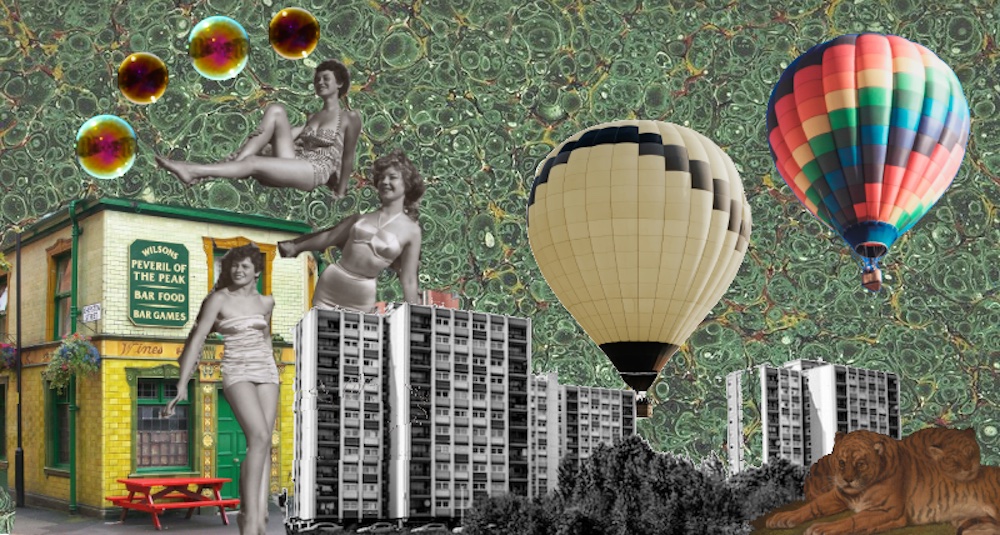
To throw the kitchen sink: How the work of Shelagh Delaney challenges the legacies of post-war social realism
Jennifer Jasmine White
Shelagh Delaney is remembered almost exclusively for her ‘gritty’ debut. Why do critics still neglect all the fun she had elsewhere? Delaney’s screenwriting credits allow us to consider what else she might have had to offer the post-war cultural landscape in Britain, and what she still might offer us today.
A Taste of Honey
In 1958, A Taste of Honey premiered at the Theatre Royal Stratford East. It was like a whirlwind crashing onto the British stage. The play was frank, funny, and sexy. It put working-class experience literally centre stage, and it didn’t seek to parody or pity, but warmly centred ordinary life in all its contradictory glory. Delaney herself was audacious, she’d sent the play to director Joan Littlewood directly, fresh out of school. The letter she attached is a remarkable read, as Delaney urged ‘I know nothing. I have nothing – only a willingness to learn – and intelligence.’ Her remarkable capacity for self-fashioning worked, and the play was staged that same year. In an interview from 1959, Delaney suggested that critical success to her meant the recognition of the working-class communities from which she came and had sought to depict. ‘The locals came in, the bricklayers and the cleaners and everything, when they said it was good, and they’d enjoyed it, I knew they meant it.’ Delaney is wry and assured in the face of an almost parodically pompous ITN interviewer. He notes the ‘sordid’ themes of Honey, asking where she got her ‘information’ from. Delaney giggles and replies that she simply applied her imagination to her observations – a formula she would play with throughout her career.
Though that interview makes for amusing viewing now, it also shows us how unshakeable Delaney’s ‘type’ was in the eyes of establishment critics. She was to be an aspirational poster-girl, an exceptional case that had grappled her way up the ladder. Even in today’s criticism, that tired meritocratic template is clear. Alongside works like John Osborne’s Look Back in Anger (1956), Delaney’s debut has come to be understood as a shorthand for ‘kitchen-sink’ realism, even for the so-called Angry Young Men that she had little in common with. The role of naïve Northern ingénue is, as Selina Todd has recently shown, a role Delaney consciously played up to in her first letter to Littlewood. It was a fiction she would never quite shake off. Where Delaney has been critically appreciated, her contributions tend to be seen as sociological, or a fluke of youthful authenticity. In fact, Delaney was an accomplished and complex artist, who threaded her gendered and classed experience through her work, but never definitionally so.
Delaney’s Experiment’s
As Joseph Darlington has suggested, Delaney’s literary work through the sixties reveals links to writers more commonly understood as ‘formally daring’. Delaney might be well read alongside some of the decade’s most notorious literary experimentalists, like Anna Kavan and BS Johnson. As I see it, she might be even better understood in a canon of formal innovation that centres on the idiosyncrasies of gendered, working-class experiences, a canon that could also include Nell Dunn, Maureen Duffy and Ann Quin, finding contemporary resonances in the work of Claire-Louise Bennett or Isabel Waidner. The curation and analysis of that canon is one of the primary impulses of my own PhD thesis. Delaney’s Sweetly Sings the Donkey (1963) is a collection of short stories that defy classification. In one, a sick young boy flamenco dances himself to death. In another, the piece is made up of collaged letters addressed to Delaney from fans, working mothers, and threatening misogynists. It’s a shame that Sweetly remains out of print, given the recent appetite for fiction of the sixties and seventies, often by women, that playfully pushes at form and convention. If such trends do indeed mark the resurgence of the ‘mid-century weirdo’ as Jennifer Hodgson has so wonderfully put it, Delaney deserves a place on the shelf.
Delaney not only went beyond the kitchen-sink realism that has come to define her, but played with and through it, interrogating inherited notions of reality and political consciousness. In two works produced in the decade that followed Honey, The White Bus and Charlie Bubbles (both 1967), a less prescriptive approach to identity and class began to come to the fore. The former is based on a short story from Sweetly, directed by Lindsay Anderson, and first imagined as part of a three-film feature by Woodfall Productions. The anthology was never released, and massively evolved over production, though Delaney was at one point pitched as the writer of all three segments. Her involvement is testament to a Delaney beyond realist theatre, and The White Bus offers a wonderfully subversive portrait of post-war Britain. Its radical charge has all too often been credited to Anderson, with Delaney relegated to footnotes, despite the central idea being hers. As tourists trundle through Manchester’s apparently triumphant rebuilt landscape, following a surreal bus tour, ‘The Girl’ speaks very little other than to politely decline the sexual advances of a pompous city mayor. Though she is the film’s central character, she seems only to watch, watching others watch her city, that much is the point of the ‘SEE YOUR CITY BUS’, to ‘see your city as it really is.’
In Charlie Bubbles, Delaney’s other sixties screenwriting credit, Albert Finney plays a young working-class writer returning to Manchester for a deeply bizarre forty-eight hours, eventually drifting off toward the clouds in an inexplicable hot air balloon. In both films, a preoccupation with what it means to watch and create, and how social class shapes those processes, is central. Exaggeratedly parochial opinions of Charlie are constantly projected onto him, as acquaintances ask similar questions in what feels like every scene: ‘Lived most of your time in London since your success, sir?’ and ‘He’s from the North, isn’t he? But he doesn’t live there anymore, does he?’ Both works utilise the stock-figure of the apparently exceptional talent that has escaped to tell it like it is, a myth Delaney herself would remain entangled with – and perhaps already knew it.
It is not just the naïve Northern artist that is satirised by these films, but the whole notion of Manchester, or indeed any place, as understood within the bounds of the ‘like it is.’ The White Bus leaves epistemological clarity beyond the viewer’s grasp. That which we instinctively read as unreal is fact – the whacky bus tour was a real example of Manchester’s civic PR efforts. Conversely, supposedly gritty realities are literal fictions – the couple that fight on the street at the end of the film take their dialogue almost verbatim from A Taste of Honey. In Charlie Bubbles, clashes of class and social mythmaking are parodied to the extreme. In the opening scenes, Charlie and a friend riotously cover each other in food as his middle-class financial advisors sternly continue their conversation in the background. Later, driving down the M6, a young Liza Minelli reveals her yearning for the glamours of Manchester, before galloping with glee through piles of rubble, unable to contain her excitement upon glimpsing the gasworks. ‘Look at the view up here!’ Minelli gushes in the manner of a wide-eyed Hollywood heroine.
(Working-class) Girls Just Want To Have Fun
These experiments with reality are particularly politically significant within this cultural context, one where working-class-ness itself was so bound up with the irrefutably ‘authentic.’ If it’s grim up North, working-class art forms in the sixties were thought predominantly valuable for their forensic documentation of the fact. Yet The White Bus refuses to delineate myth from reality, and Charlie Bubbles stretches and inverts conventional narratives of aspiration and authenticity to such an extent as to reveal the bizarre unreality at their core. In Delaney’s scripts, working-class stories might also be surreal, non-linear, and downright weird. At the end of Charlie Bubbles, Charlie notices a hot air balloon from his window and silently walks towards it before climbing in, cutting the rope, and sailing off above the clouds. In a film that has parodied the tensions surrounding working-class aspiration and its chronicling, such a moment is a final gesture towards the refusal of a ‘conventional’ social realism. Only the most absurdly physical rendering of upwards mobility will do.
The lack of attention given to Delaney is partly the product of deep-set political biases against her as a working-class woman. Delaney is by no means a singular authority on Northern working-class life, nor should her work be understood exclusively as a product of that positionality. Yet works such as The White Bus and Charlie Bubbles show what is possible when working-class women are given the space to render their experiences through consciously playful and imaginative forms, and that much bears exploring further.
Only recently for instance has the work of Delaney’s contemporary, Lorenza Mazzetti, found critical recognition in Britain. The Free Cinema movement, in which Mazzetti was intimately involved, provided one opportunity for a form of social realism that didn’t shy away from experiment. Joan Littlewood’s plans for a ‘Fun Palace’, a site that reimagined working-class consciousness through radical play and freedom, gesture towards another.
On Delaney’s under-acknowledged legacies, Anna Coatman has written brilliantly for Sight and Sound. It seems obvious to suggest that the formally experimental and the socially conscious might coexist, yet neglect of Delaney’s later works is just one instance of resistance to such ideas. As I continue to research, further possibilities for dialogue between experimental or avant-garde feminist works and the legacies of social realism and working-class culture emerge. Previously perceived as mutually exclusive spheres, writers like Delaney prove they might in fact be held in duality.
Short Bio
 Jennifer Jasmine White is a PhD candidate at the University of Manchester, with first-class degrees from the University of Cambridge (BA) and the University of Oxford (MSt). Her thesis explores the relationship between experimental form, women’s writing, and working-class culture. Her PhD is fully funded by a President’s Doctoral Scholarship.
Jennifer Jasmine White is a PhD candidate at the University of Manchester, with first-class degrees from the University of Cambridge (BA) and the University of Oxford (MSt). Her thesis explores the relationship between experimental form, women’s writing, and working-class culture. Her PhD is fully funded by a President’s Doctoral Scholarship.
For more about her research, you can find her on Twitter: @Jennifer_J_W

0 Comments